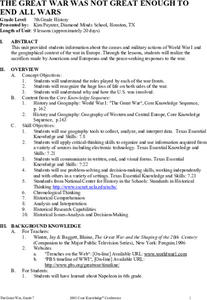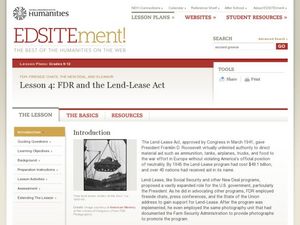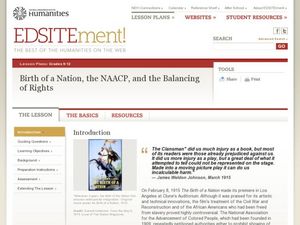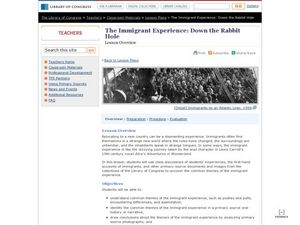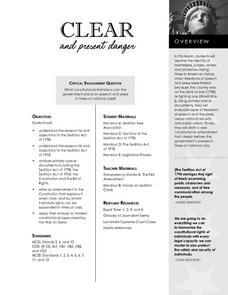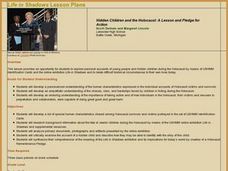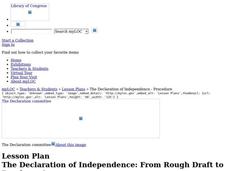Curated OER
Grapes of Wrath as a Primary Source
Eighth graders consider the plight of migrant farmers during the Great Depression. In this historical perspectives lesson, 8th graders watch the film based on Steinbeck's The Grapes of Wrath and then discuss the conditions the characters...
Curated OER
George Washington and the Rule of Law
students compare The rule of law with the rule of men and consider life under each of these types of governments.In this government lesson, students read a primary source to examine the importance of the rule of law.They will also answer...
Curated OER
The Great War Was Not Great Enough To End All Wars
Students examine the causes and military actions of World War I. In this World History lesson, students study the sacrifices made by Americans and Europeans. Students read and analyze primary sources related to World War I.
Curated OER
FDR and the Lend-Lease Act
Young scholars analyze primary source documents and photographs to analyze the implications of the Lend-Lease Program. In this research lesson plan, students read and discuss letters and speeches related to the Lend-Lease Act, evaluate...
Curated OER
Streamlines and Breadlines
Students explore the Great Depression. In this Great Depression instructional activity, students research selected websites and analyze primary sources to conduct inquiries regarding the depression, northern migration, and urbanization....
Curated OER
Birth of a Nation, the NAACP, and the Balancing of Rights
Eleventh graders analyze primary sources. In this US History instructional activity, 11th graders interpret written information. Students evaluate arguments and draw conclusions. Students develop and defend a position.
Curated OER
The Study of the Spanish-Speaking People of Texas: Understanding Primary Sources
Students analyze Russell Lee's photo essay as a sign of segregation in Texas. They consider the differences between primary and secondary sources and how historians use these sources.
Curated OER
Working Women of WWII: Primary Documents: The Editorial Cartoon
Students examine the role of women in the workplace during World War II. They identify social conflicts, view and analyze editorial cartoons, participate in a group discussion, and answer discussion questions.
Curated OER
Old Hickories
Students analyze historical events to develop a historical perspective. For this critical analysis lesson, students read excerpts, primary sources and other materials in order to understand the Native American Removal that occurred...
Curated OER
Cult of Domesticity
Eleventh graders explore the role of women in 1800's America. In this women's history lesson, 11th graders examine excerpts of "An Essay on Slavery and Abolitionism with Reference to the Duty of American Females," and "Letters to...
Curated OER
Lesson 11: Printed Materials (Ads and Broadsides) 1780-1820
Students use primary resources (gazettes, broadsides, advertisements) to consider life at the turn of the 18th century in Deerfield, Massachusetts. They infer observations about life in the nascent United States.
Curated OER
The Immigrant Experience: Down the Rabbit Hole
Young scholars relate the immigrant experience to Lewis Carroll's Alice's Adventures in Wonderland. In this immigration experience lesson, students read Lewis Carroll's Alice's Adventures in Wonderland and relate it to the immigrant...
Curated OER
Consequences of Individual Choices
High schoolers take the sides of Patriots or Tories. In this colonial American lesson, students read primary sources that feature James Murray and Captain Jones. High schoolers then write dialogues and limericks based on a fictional...
Curated OER
The Man Who Made the Presidency
High schoolers explore the contributions that George Washington made to the presidency. In this presidential history lesson, students analyze primary and secondary sources regarding Washington and the precedents he set. High schoolers...
Curated OER
Clear and Present Danger
Students assume identities of lawmakers, judges, writers, and protestors during times in American history when freedoms of speech and press were limited because country was on the brink of war or fighting one. Students use primary source...
Curated OER
Westmoreland Trail
Seventh graders complete a unit of lessons on the Westward expansion of the U.S. They play the computer game, Oregon Trail III, read primary source documents, conduct Internet research, write diary entries from the pioneer viewpoint, and...
Curated OER
Hidden Children and the Holocaust: A Lesson and Pledge for Action
Students read various personal accounts of children during the Holocaust. Using special identification cards, they relate the Holocaust to historical events in their lifetimes. Examining primary source documents, they describe how they...
Curated OER
Women Suffered to Achieve Suffrage
Students compare and contrast the movement for suffrage in Nebraska and the U.S. They organize and interpret primary documents and images from the time period. In addition, they tie in religious movements to women's suffrage.
Curated OER
The Declaration of Independence: From Rough Draft to Proclamation
High schoolers discover how the Declaration of Independence transformed from a draft to a treasured historical document. In this Declaration of Independence lesson, students discuss the context in which Jefferson wrote the document and...
Curated OER
Exploring US Foreign Policy after WWII--The Cold War
Scholars explore U.S. Foreign Policy and Cold War ideologies adopted after WWII. They conduct Internet research on a topic or issue related to the Cold War Era, watch two films, and compose a time line and a multimedia presentation to...
Center for History Education
Should the Colonists Have Revolted Against Great Britain?
Should the Americans have taken the plunge and revolted against Great Britain? Using documents, including the famed Common Sense and a Loyalist response, pupils conduct a lengthy investigation of the question. The interesting resource...
Civil War Trust
Civil War Newspaper
One photograph can represent so much more than the images on the film. Eighth graders select a photograph from the Civil War era and conduct additional research based on the subject matter from the picture. Once they complete the...
Roy Rosenzweig Center for History and New Media
Immigration: Why Come to the United States?
Don't limit your curriculum to texts! Young historians listen to a song, read an interview, and examine a cartoon as they explore motivations for immigrating to the US in the late 19th and early 20th centuries.
American Institute of Physics
African American Inventors in History
A two-part lesson introduces young historians to the work of famous African American inventors. Groups first research and develop a presentation of an inventor that includes biographical information and information about one of their...




